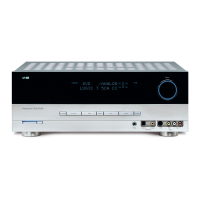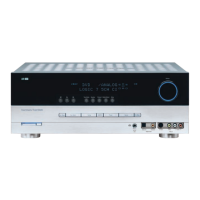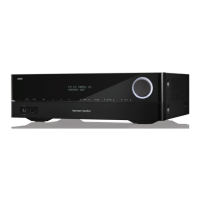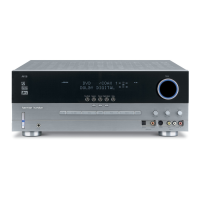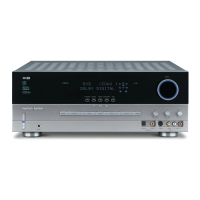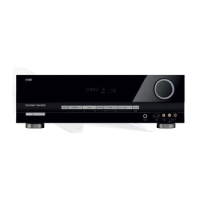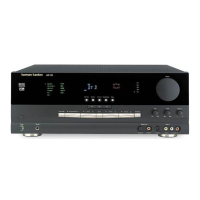individual modes available. For example, press this
button to select Dolby modes, and then press the
Surround Mode Selector 8 to choose from the
v
arious Dolby mode options.
8 S
urround Mode Selector:
P
ress this button
t
o select from among the available surround mode
options for the mode group selected. The specific
modes will vary based on the number of speakers
available, the mode group and if the input source is
d
igital or analog. For example, press the
S
urround
Mode Group Selector
7 to select a main mode
grouping such as Dolby or Logic 7, and then press
this button to see the specific mode choices available.
Note that the digital surround modes, such as Dolby
Digital and DTS, may not be accessed unless that type
of source signal is present, such as when a DVD movie
or television signal programmed in Dolby Digital or DTS
surround sound is playing. For more information on sur-
round mode selection, see pages 18 and 27.
9 Tuning Selector: Press the left side of the button
to tune lower-frequency stations and the right side of
the button to tune higher-frequency stations. When the
tuner is in the Manual mode, each tap will increase or
decrease the frequency by one increment. When the
tuner receives a strong enough signal for adequate
reception,
MANUAL TUNED will appear in the
on-screen display and the
Lower Display Line ı.
When the tuner is the Auto mode, press the button
once, and the tuner will scan for a station with accept-
able signal strength. When the next station with a
strong signal is tuned the scan will stop and the
on-screen display and
Lower Display Line ı
will indicate AUTO TUNED. When an FM
Stereo station is tuned,
the display will read
AUTO ST TUNED.
To switch back and forth between the Auto and
Manual tuning modes, press the
Tuner Mode
Selector
&.
) ‹/› Buttons: When configur
ing the AVR 140’s
settings, use these buttons to select from all of the
available choices
.
! Tuner Band Selector: Press this button to turn
the A
VR on and to select the
T
uner as the input.
Press
it again to switch between the AM and FM frequency
bands. (See page 33 for more information on the tuner.)
@ Set Button: When making choices during the
setup and configuration process, press this button to
enter the desired setting into the AVR 140’s memory.
# Digital Input Selector: Press this button to
select one of the digital audio inputs or the analog
audio input for any source. (See pages 27–33 for
more infor
mation on digital audio
.)
$ Preset Stations Selector: Press this button to
scroll up or down through the list of stations that have
been entered into the preset memory. (See page 33
for more information on tuner presets.)
% Delay Adjust Selector: Press this button to
begin the steps required to enter delay settings. (See
p
ages 22–23 for more information on delay times.)
^ Input Source Selector: Press this button to
c
hange the input by scrolling up or down through the
list of
Input Indicators Ú.
& Tuner Mode Selector: Press this button to select
Auto or Manual tuning. When the button is pressed so
that
AUTO appears in the Lower Display Line ı,
t
he tuner will search for the next station with an accept-
able signal whenever the
T
uning Selector
9u
is pressed. When it is pressed so that MANUAL
appears in the Lower Display Line ı, each press
of the
T
uning Selector
9u will increase the fre-
quency. This button may also be used to switch
between Stereo and Mono modes for FM radio recep-
tion. When weak reception is encountered, press the
button so that
MANUAL appears in the Lower
Display Line
ı and in the on-screen display to
switch to Mono reception. Press it again to switch back
to Stereo mode. (See page 33 for more information on
using the tuner.)
* Optical 3 Digital Audio Input: Connect the optical
digital audio output of an audio or video product to this
jack. When the input is not in use, the built-in shutter will
close to avoid dust contamination that might degrade
future performance.
( Coaxial 3 Digital Audio Input: This jack is used
for connection to the output of portable audio devices,
video game consoles or other products that have a
coax digital audio jack.
Ó Video 3 Video Input Jacks: These jacks may
be used for temporary connection to the composite or
S-video
output of video games, camcorders or other
portable video products. You may make a connection
to either jack at any time,
but not to both simultaneously.
Ô Video 3 Audio Input Jacks: These audio jacks
may be used for temporary connection to video
games or portable audio/video products such as
camcorders and portable audio players.
NOTE: The
A
VR 140 is shipped with two covers that
may be installed over the front-panel input jacks when
they are not in use.
Channel Adjust Selector: Press this button to
begin the process of trimming the channel output lev
-
els using an exter
nal audio source
.
(F
or more infor
ma
-
tion on output level trim adjustment, see page 23.)
Ò V
olume Control:
T
urn this knob clockwise to
increase the volume, counterclockwise to decrease
the volume
.
If the
AVR 140 is muted, adjusting the
V
olume Control
Òb w
ill automatically release the
unit from the silenced condition.
Ú Input Indicators: The current selected source will
appear as one of these indicators. Note that when the
unit is turned on, the entire list of available modes will
l
ight briefly, and then revert to normal operation with
only the active mode indicator illuminated.
NOTE: When /DMP has been selected as
the input source, no
Input Indicator Ú will light.
DMP/THE BRIDGE IS CONNECTED
will scroll across the Upper Display Line Ù, unless
you have retitled the source name, in which case only
that name will appear. See page 17 for more informa-
tion on input titling.
Û Speaker/Channel Input Indicators: These indi-
cators are multipurpose, indicating both the speaker
type selected for each channel and the incoming data-
signal configuration. The left, center, right, right surround
and left surround speaker indicators are composed of
three boxes, while the subwoofer is a single box. The
center box lights when a “small” speaker is selected,
and the two outer boxes light when “large” speakers are
selected. When none of the boxes are lit for the center,
surround or subwoofer channels, no speaker has been
assigned that position. (See page 20 for more informa-
tion on configuring speakers.)
The letters inside each box display the active input
channels. For standard analog sources, only the L and R
will light, indicating a stereo input. For a digital source,
the indicators will light to display the channels being
received at the digital input. When the letters flash, the
digital input has been interrupted. (See page 31 for
more information on the Channel Indicators.)
Ù Upper Display Line: Depending on the unit’s sta
-
tus, a variety of messages will appear here. In normal
operation, this line will show current input source and
which analog or digital input is in use
.
When the tuner is
the input, this line will identify the station as AM or FM
and show the frequency and preset number, if any.
ı Lower Display Line: Depending on the unit’s sta-
tus, a variety of messages will appear here. In normal
operation,
the current surround mode will show here
.
ˆ Surround Mode Indica
tors:
The current selected
surround mode will appear as one of these indicators.
Note that when the unit is turned on, the entire list of
available modes will light briefly, and then revert to
nor
mal operation
with only the active mode indicator
illuminated.
˜ Remote Sensor Window: The sensor behind
this window receives infrared signals from the remote
control. Aim the remote at this area and do not block
or cover it.
FRONT-PANEL CONTROLS
6 FRONT-PANEL CONTROLS
FRONT-PANEL CONTROLS
6 FRONT-PANEL CONTROLS
AVR 140 OM 3/29/06 3:45 PM Page 6
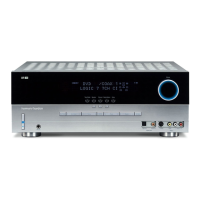
